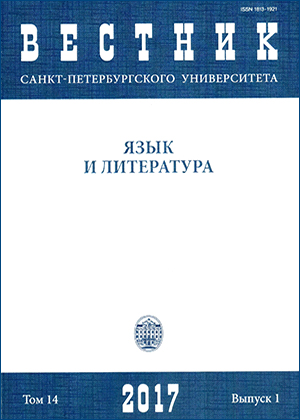Sound Contraction at Word Boundaries in Spontaneous and Read-Aloud Speech: Evidence from Russian
DOI:
https://doi.org/10.21638/11701/spbu09.2017.107Abstract
This study quantifies all possible vowel and some consonant contractions that occur within word boundaries. It is based on data from spontaneous and read-aloud Russian. The data for word-external contractions are compared with the data for the word-internal ones. External word-external contractions evoke fading of word boundaries that can lead to speech segmentation problems. Patterns of contraction formation and possible marks of contractions, contraction markers are investigated. Theresults reveal no strict rules to predict contractions. Duration of consonants was not proved to be a reliable feature that a listener could use in the process of recognition. Stress, on the other hand, seems to play a significant role for vowels: unstressed vowels are more likely to contract easier than stressed ones involved in contracted forms.
Downloads
References
Bibliography:
Богданова-Бегларян 2013 — Bogdanova-Beglarian, N. V. (ed.). Zvukovoi korpus kak material dlia analiza russkoi rechi [Speech corpus as a source of Russian speech analysis]. Vol. 1: Чтение. Пересказ. Описание [Reading. Retelling. Description]. St. Petersburg, Philol. faculty (St. Petersburg State Univ.) Publ., 2013. 536 p. (in Russian)
Бондарко и др. 2004 — Bondarko, L. V., Verbitskaya, L. A., Gordina, M. V. Osnovy obshchei fonetiki [Basicsof general phonetics]. St. Petersburg, Philol. faculty (St. Petersburg State Univ.) Publ., 2004. 160 p. (in Russian)
Венцов и др. 2013 — Ventsov, A. V., Nigmatulina, Y. O., Rayeva, O. V., Riekhakainen, E. I., Slepokurova, N. A. Korpus russkikh spontannykh tekstov: struktura i edinitsy [Corpus of Russian spontaneous texts: structure and items]. In: Trudy mezhdunarodnoi konferentsii «Korpusnaia lingvistika–2013» [Proceedings of the international conference “Corpus linguistics — 2013”] (St. Petersburg, 25–27 June, 2013). St. Petersburg, Philol. faculty (St. Petersburg State Univ.) Publ., 2013, pp. 223–231. (in Russian)
Зализняк 1967 — Zaliznyak, A. A. Russkoe imennoe slovoizmenenie [Nominal inflection in Russian]. Moscow, Nauka Publ., 1967. 370 p. (in Russian)
Земская 1973 — Zemskaya, E. A. (ed.). Russkaia razgovornaia rech' [Colloquial Russian]. Moscow, Nauka Publ., 1973. 485 p. (in Russian)
Земская 2006 — Zemskaya, E. A. Russkaia razgovornaia rech': lingvisticheskii analiz i problemy obucheniia [Colloquial Russian: linguistic analysis and teaching problems]. Moscow, Flinta; Nauka Publ., 2006. 239 p. (in Russian)
Касаткин, Чой 2005 — Kasatkin, L. L., Choi, M. C. Dolgota / kratkost' soglasnogo na meste sochetaniia dvukh soglasnykh bukv v sovremennom russkom literaturnom iazyke [Length of consonants in two-component consonant clusters in modern Russian literary language]. Moscow, LRC Publ., 2005. 320 p. (Studia philologica). (in Russian)
Риехакайнен 2010 — Riekhakainen, E. I. Fonetika spontannoi rechi v pertseptivnom aspekte [Phonetics of spontaneous speech in the aspect of perception]. In: XXXIX Mezhdunarodnaia filologicheskaia konferentsiia. Sektsiia «Psikholingvistika» [Proceedings of the XXXIX international Philological conference. Section «Psycholinguistics»]. St. Petersburg, March, 15–20, 2010. St. Petersburg, Philol. faculty (St. Petersburg State Univ.) Publ., 2010, pp. 57–61. (in Russian)
Светозарова 1988 — Svetozarova, N. D. (ed.). Fonetika spontannoi rechi [Phonetics of spontaneous speech]. Leningrad, Leningrad State Univ. Publ., 1988. 248 p. (in Russian)
Чистович 1976 — Chistovich, L. A. (ed.). Fiziologiia rechi. Vospriiatie rechi chelovekom [Physiology of speech. Human speech perception]. Leningrad, Nauka Publ., 1976. 386 p. (in Russian)
Cabrй, Prieto 2005 — Cabrй, T., Prieto, P. Positional and metrical prominence effects on vowel sandhi in Catalan. In: Frota, S., Vigбrio, M., Freitas, M. J. (eds.). Proceedings of the conference «Prosodies: With Special Reference to Iberian Languages» 2005. Berlin; New York: Mouton de Gruyter, 2005, pp. 123–158. (in English)
Casali 1997 — Casali, R. F. Vowel elision in hiatus contexts: which vowel goes? In: Language. 1997, vol. 73, iss. 3, pp. 493–533. (in English)
Esposito, Di Benedetto 1999 — Esposito, A., Di Benedetto, M. G. Acoustical and perceptual study of gemination in Italian stops. In: JASA — Journal of the Acoustical Society of America. 1999, vol. 106, iss. 4, pp. 2051–2062. (in English)
Hankamer et al. 1989 — Hankamer, J., Lahiri A., Korenan, J. С. Perception of consonant length: voiceless stops in Turkish and Bengali. In: Journal of Phonetics. 1989, vol. 17, pp. 283–298. (in English)
Nespor et al. 1987 — Nespor, M., Kaisse, E. M., Zwicky, A. M. Vowel degemination and fast speech rules. In: Phonology Yearbook. 1987, vol. 4, Iss. 1, pp. 61–85. (in English)
Pickett, Decker 1960 — Pickett, J. M., Decker, L. R. Time factors in the perception of a double consonant. In: Language and Speech. 1960, vol. 3, pp. 11–17. (in English)
Smith et al. 2008 — Smith, J. M., Flores, T. L., Gradoville, M. S. An analysis of vowels across word boundaries in Veracruz, Mexican Spanish. In: IULC Working Papers. 2008, vol. 8, no. 1. URL: https://www.indiana.edu/~iulcwp/wp/article/view/08-07. (accessed: 31.10.2016). (in English)
Downloads
Published
How to Cite
Issue
Section
License
Articles of "Vestnik of Saint Petersburg University. Language and Literature" are open access distributed under the terms of the License Agreement with Saint Petersburg State University, which permits to the authors unrestricted distribution and self-archiving free of charge.






